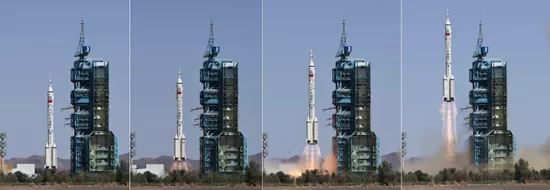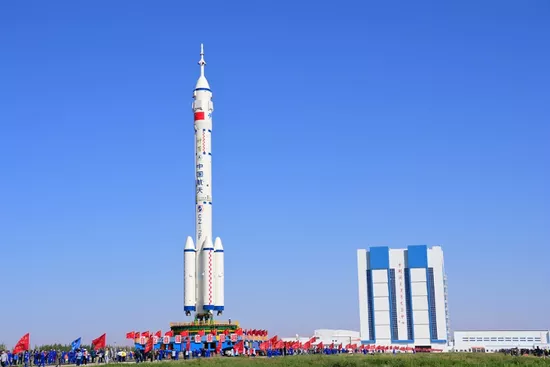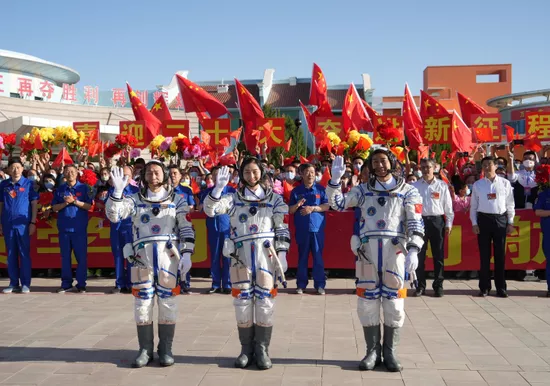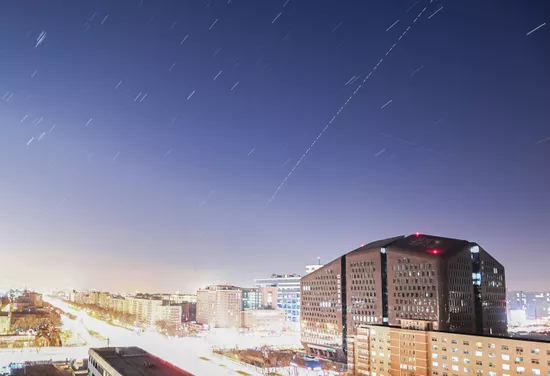With mountains and seas in mind and stars in eyes. The vast space once again welcomes the Chinese people to pursue their dreams. On the morning of June 5, the long march 2F Yao 14 carrier rocket carrying the Shenzhou 14 manned spacecraft ignited and lifted off at the Jiuquan Satellite Launch Center, successfully sending astronauts Chen Dong, Liu Yang and caixuzhe into space. The first manned mission in the construction phase of China's space station was successfully launched.

The launch of Shenzhou 14 manned spacecraft was a complete success. Photographed by Xinhua News Agency reporter Ligang
After Shenzhou 14 manned spacecraft entered orbit, it adopted radial autonomous rapid rendezvous and docking mode to dock with the space station assembly. Three astronauts will enter the space station's space and core modules, officially opening a six-month space trip. During the in orbit stay, the Shenzhou 14 flight crew will welcome the visit and docking of the two experimental modules of the space station, the Tianzhou 5 cargo spacecraft and the Shenzhou 15 manned spacecraft, and carry out in orbit rotation with the Shenzhou 15 flight crew, which can be called the "busiest three person group for space travel". What are the highlights of this launch mission? What are the missions of the Shenzhou 14 flight crew?

On May 29, the Shenzhou 14 manned spacecraft and the Long March 2 F remote 14 carrier rocket assembly were on their way to the launch area. Issued by Xinhua News Agency (photographed by wangjiangbo)
On the March: "Shenjian" set a new record
The long march 2F Yao 14 carrier rocket, which carried out the launch mission, stood for nearly 10 months, breaking the previous record of Yao 13 rocket standing for more than 6 months.
Why is it so long before the rocket is launched? Experts told reporters that since the Shenzhou 12 flight mission, the long march 2F carrier rocket has adopted the launch mode of "one launch, one backup" and "rolling backup", adding "double insurance" to the life safety of astronauts.
The long march 2F Yao 14 carrier rocket launched this time is the emergency rescue rocket for the Shenzhou 13 mission. With the successful return of the Shenzhou 13 flight crew on April 16, the Yao 14 rocket also ended its emergency rescue duty and changed from an emergency state to a normal mission state.
Jing muchun, commander in chief of the long march 2F carrier rocket of the first Academy of China Aerospace Science and Technology Corporation, introduced: "in the history of China's manned space flight, the long march 2F carrier rocket has carried out the launch missions of all manned spacecraft and target aircraft since Shenzhou I, with a launch success rate of 100%, and is known as China's divine arrow."
In order to further improve the reliability of the rocket and eliminate the weak links, the development personnel continue to make technical improvements.
"It's just like that the exam score should be raised from 90 to 91, or even 91.1. Even if it is 0.1, there is not much work behind it." Said changwuquan, chief designer of the long march 2F carrier rocket of the first Academy of China Aerospace Science and Technology Corporation.
For this reason, the development team not only carried out special test verification on the rocket in the long-term upright state, such as the load-bearing capacity of initiating explosive devices and the pretightening force of bolts, but also ensured the environmental conditions such as temperature and humidity when the rocket was upright. It also retested the tightening torque of bolts on the rocket and the tightness of sealing products after the rocket turned into the normal mission state.
During the preparation for the launch of the yao-14 rocket, the model team also needs to synchronously carry out the assembly and testing of the yao-15 rocket and complete the setting of the emergency rescue status.
"Through the parallel and optimization of the implementation process of the two missions last year, the preparation time for the launch this year is expected to be further shortened." Chang Wuquan said.

On June 5, the expedition ceremony for the astronauts of Shenzhou 14 manned mission was held at Wentiange square of Jiuquan Satellite Launch Center. Chen Dong (right), Liu Yang (middle) and caixuzhe are about to launch a six-month flight mission. Photographed by Xinhua News Agency reporter Ligang
Objective: to build the National Space Laboratory
According to the manned space engineering plan, marked by the successful return of the Shenzhou 13 manned spacecraft on April 16, 2022, the Chinese space station has successfully completed the tasks of the key technology verification phase, moved into the full-scale construction phase, and will be fully completed in the second half of 2022.
The Shenzhou 14 mission is the second mission in the construction phase of the space station and the first manned mission in this phase. The astronauts will work and live in orbit for six months.
During the in orbit stay, the three astronauts of the Shenzhou 14 flight crew will welcome the visit and docking of the two experimental modules of the space station, the Tianzhou 5 cargo spacecraft and the Shenzhou 15 manned spacecraft, carry out in orbit rotation with the Shenzhou 15 flight crew, and return to earth in December.
The Shenzhou 14 flight crew on this expedition can be called the "busiest three person group for space travel". They shoulder the important mission of completing the on orbit assembly and construction of China's space station.
"During the six-month flight, the astronauts have to experience extremely complex flight conditions, including nine combinations, five rendezvous and docking, three separation and evacuation, and two transposition missions." Huangweifen, chief designer of the astronaut system of China's manned space project and researcher of the Chinese Astronaut Research and training center, said.
"During the Shenzhou 14 mission, the construction of Tiangong space station with the basic configuration of Tianhe core module, Wentian experimental module and Mengtian experimental module will be fully completed, and the national space laboratory will be built. Among them, Wentian experimental module is mainly for space life science research, and Mengtian experimental module is mainly for microgravity science research." Linxiqiang, spokesman for China's manned space program and deputy director of the China Manned Space Program Office, said.
The Shenzhou 14 mission is a key battle during the construction period of China's space station. It is more difficult and challenging. Chen Dong, the commander of the mission, said before the departure: "our team will resolutely complete the mission with full confidence, full blood and full score."

The transit photo of the Chinese space station (the track is a stack of photos) was taken at Xuanwumen, Beijing on December 19, 2021. Photographed by Xinhua News Agency reporter chenyehua
Outlook: manned spaceflight will start again in the "30's"
It has been nearly 30 years since China's manned space program was officially approved for implementation in September, 1992.
From shenzhou-1 to Shenzhou-5 to shenzhou-14, from one person entering space one day to many people entering space many days, and then to staying in space for three or six months... The blueprint of China's space station has been drawn, and the dream of flying into the sky extends further into the sky.
The construction of a space station and a national space laboratory is an important goal of the "three-step" strategy of China's manned space project, and an important leading project to build a strong country in science and technology and aerospace.
However, at the beginning of the space station project, Chinese astronauts faced many difficulties, such as what kind of space station master, what kind of technical route to follow, how to build... The task is very arduous.
The preparation for development has lasted for ten years. Many space station engineers and researchers have been pursuing and dreaming of building a Chinese space station for ten years, making breakthroughs in one key technology after another and solving one complex technical problem after another.
HaoChun, director of the China Manned Space Engineering Office, said that after the completion of the on orbit construction of the space station, the project will enter the application and development stage for more than 10 years. The initial plan is to launch two manned spacecraft and two cargo spacecraft every year. Astronauts should stay in orbit for a long time, carry out space science and technology experiments, and take care of and maintain the space station.
In addition, China will also develop a new generation of manned launch vehicles and a new generation of manned spacecraft, which can be reused. The new generation of manned spacecraft can carry seven astronauts.
"At the same time, we are considering developing the expansion module of the space station to create better conditions for further supporting on orbit scientific experiments and for the work and life of astronauts." HaoChun said.
Reporter: Huzhe, songchen, liguoli
Editor: chenyuming
Vision: comfortable and quiet